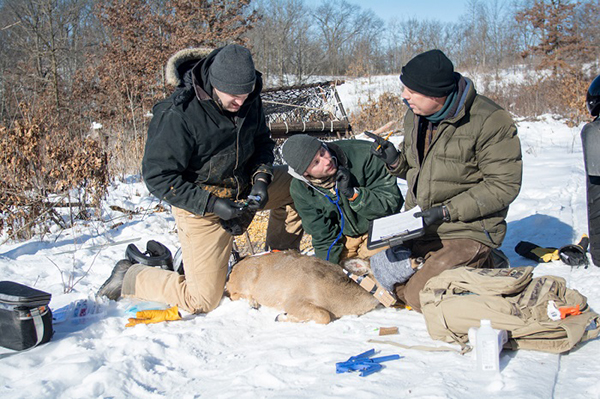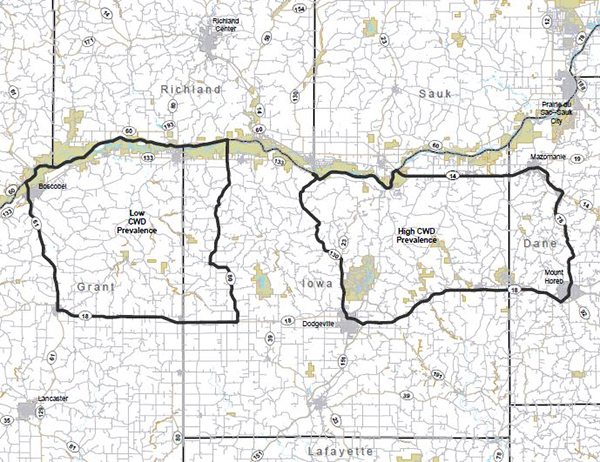DNR Continues to Implement its CWD Response Plan
MADISON - Following a review of its 15-year Chronic Wasting Disease Response Plan, the Department of Natural Resources will continue to work on existing action items and implement new recommendations received during the review process.
The CWD Response Plan covers action items like surveillance and monitoring, education and outreach, biosecurity and safety, research, and public involvement.
Over the past several months, DNR, the Department of Agriculture, Trade, and Consumer Protection, and Wisconsin Conservation Congress worked closely with a stakeholder-based CWD Response Plan review committee to discuss and review the response plan.
In January 2017, preliminary recommended actions items from this committee and public feedback were provided to County Deer Advisory Councils in every county to collect public input and to provide county specific recommendations. Final recommendations were provided to the Natural Resources Board on March 1, 2017. DNR staff will provide updates on accomplishments toward these recommendations at the Natural Resources Board meeting in December 2017.
To learn more about the CWD Response Plan, visit dnr.wi.gov<http://dnr.wi.gov/> and search keywords "CWD response plan<http://dnr.wi.gov/topic/wildlifehabitat/cwdplan.html>."
Continued commitment to learning more about CWD in Wisconsin
In May 2016, Gov. Scott Walker announced steps to further help understand the dynamics of CWD in Wisconsin. These steps included seeking input from hunters, landowners, farmers, and foresters in every county using County Deer Advisory Councils; directing the DNR to conduct a comprehensive study of deer population dynamics; creating best management practices for urine based scents; and developing quicker test results for hunters.
A voluntary industry-based program intended to help minimize the potential spread of CWD through the use of cervid urine based sent products has been initiated. For more information on recommended uses of scents as they pertain to CWD, please visit dnr.wi.gov and search "urine-based scents."
Southwest Wisconsin CWD, Deer and Predator Study wraps up first year of deer trapping efforts with help from 117 landowners

Fall 2016 kicked off the early stages of the Southwest Wisconsin CWD, Deer and Predator Study. This groundbreaking research in southwest Wisconsin stems from Governor Walker's commitment to reevaluate chronic wasting disease in Wisconsin.
[http://dnr.wi.gov/images/news/2017/20170224_swstudy1.jpg]
Photo Credit: DNR
Through this study, DNR staff hope to learn more about Wisconsin's wildlife in portions of Dane, Iowa and Grant counties. The study will evaluate factors like predation, habitat conditions, hunter harvest, and chronic wasting disease to measure impacts on deer survival and deer populations in southern Wisconsin.
As of late March 2017, GPS collars have been placed on 141 deer, six bobcats, and seven coyotes.
[The eastern most study area is found within the area of highest CWD prevalence, while the western most study area has a much lower rate.]

The eastern most study area is found within the area of highest CWD prevalence, while the western most study area has a much lower rate.
Photo Credit: DNR
This project relies heavily on cooperation from a number of volunteers - DNR staff would like to thank the 117 landowners (and counting) who have agreed to assist with this research and remind others in southwest Wisconsin to consider becoming involved as the study moves forward.
Information gathered from this study will aid the DNR and CDACs in managing the deer herd.
For more information regarding the Southwest Wisconsin CWD, Deer and Predator Study and how to become involved, search keywords "deer research<http://dnr.wi.gov/topic/wildlifehabitat/research/whitetaileddeer.html>." To receive email updates regarding deer research in Wisconsin, visit dnr.wi.gov and click on the email icon near the bottom of the page titled "subscribe for updates for DNR topics<https://public.govdelivery.com/accounts/WIDNR/subscriber/new>," then follow the prompts and select the "white-tailed deer research" list.
And, be sure to follow the department's Facebook<https://www.facebook.com/WIDNR> and Twitter<https://twitter.com/WDNR> accounts for project updates and photos from the field.











